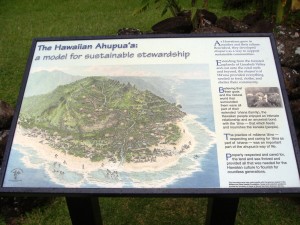- The Green Revolution has messed with rice rituals in Bengal.
- National Pig Day is coming up. Bacon for breakfast at last!
- The Star Trek tricorder finally arrives, though only for plant diseases so far.
- Organic beer can be good. You had me at beer.
- Speakin’ of bacon, make mine endangered.
- Biodiversity Fair held in Bhutan “to recognise the farmers’ contribution …; create awareness … and encourage farmers …; promote in situ conservation and … ex situ (gene bank) conservation; and provide … opportunities to exchange seeds.”
Hawaiian agrobiodiversity memories
I came across an evocative little piece in The Garden Island on Sunday, thanks to a Google alert. It’s about an upcoming course on permaculture design that will be looking in depth at the ahupua’a, the old Hawaiian practice of land subdivision and management.
To ensure adequate space for forests and agriculture in each ahupua’a, pre-colonial Hawaiian communities applied careful land-use planning. Valley floors, where the most fertile soil is concentrated, were reserved for agriculture. They often included walled-terraces developed to grow kalo (taro), the most important staple food crop for Hawaiians. Houses were built on hillsides and in sandy areas in order to save prime agricultural lands. As contemporary Kaua’i attempts to move towards more self-sufficient communities, we can look towards this model of reserving prime agricultural lands for agriculture to perpetuate our ability to feed ourselves.
The piece reminded me of a visit I made with the family to the Limahuli Garden and Preserve on Kaua’i. It’s a beautiful place, explicitly organized around the ahupua’a concept.

And it even maintains small collections of different varieties of local root crops such as taro and sweet potato. Which was mainly why I was there. Although the visit came too late to allow me to include the data in the directory of Pacific collections. Maybe the next edition…

Up is the new down
Further to Luigi’s trend-setting (and spotting) piece positing that an economic downturn could mean an upturn for agricultural biodiversity, I note from our friend Danny Hunter’s blog that LEISA is asking its local partners a couple of germane questions:
What are the effects of the global economic crisis that you see in your own environment, at the level of target groups (e.g. food prices, changes in agriculture, availability of credit, etc…)?
Does it affect the functioning of your own organisations or networks? How?
Answers are coming in, and LEISA is continuing the discussion on an open forum. Anyone care to fillet the answers for agrobiodiversity-specific information?
Nibbles: Trees, Fibres, Journal, Local sourcing, d’Yquem, Capybaras
- Sacred groves explained.
- Filipinos encouraged to grow fibres.
- New AJFAND is out.
- “Inclusive business models†good for livelihoods, maybe agrobiodiversity too.
- Because it’s there. Disease and fermentation.
- There’s a booming market for chiguiro meat in Venezuela, which is bad for the chiguiro in Colombia.
Agrobiodiversity in trouble in Cameroon
Ivo Arrey Mbongaya of the African Centre for Community and Development in Cameroon has a blog on the Eldis Community and has recently discussed threats to two different sorts of agricultural biodiversity in his country. Apparently, goat rearing is in decline, because of the disappearance of grazing land, harsh policies about strays and the lack of veterinary services. He doesn’t say if a local breed is involved, however, and does make reference to “efforts by Heifer Cameroon to distribute cheap animals.”
Also in trouble is “eru,” or Gnetum africanum, a shrub whose leaves are consumed as a green vegetable. Unsustainable harvesting and land use changes are taking their toll, and Ivo recommends taking the plant into domestication.There’s been some work on that by ICRAF and others.